May is the month of Prader-Willi Awareness.
The aim of Prader-Willi Awareness month is to create a better understanding and a supportive environment for individuals living with Prader-Willi Syndrome and their families.
What is Prader-Willi Syndrome?
Prader-Willi Syndrome (PWS) is a complex genetic and life-long disorder that occurs when chromosome 15 is deleted or atypically expressed. This results in the dysfunction of the hypothalamus, the part of the brain that is responsible for keeping the body in a balanced state by regulating body temperature, hunger, thirst, emotions and hormone production. PWS is typically characterised by abnormal body composition, small hands and feet, developmental delays and behavioural concerns. It affects both males and females and all ethnicities equally with a prevalence of 1 in 10,000 to 30,000 births in Australia.
How does it affect an individual’s health?
According to Prader-Willi Syndrome Australia, those living with this condition have a constant debilitating pre-occupation with food, because their body’s ability to feel satiety (full) is impaired. This is accompanied by an unrelenting physical drive to eat which leads to excessive eating and, typically, life threatening obesity. As a result, an individual living with PWS has dramatically reduced lean body tissue and increased fat mass. This can lead to reduced physical ability and other health complications (including obesity, type 2 diabetes and cardiovascular disease), impacting the individual’s health and wellbeing, quality of life and lifespan. According to Butler, J. et al. (2002), the prevalence rate of individuals with Prader-Willi Syndrome to be found with type 2 diabetes is 25% with a mean onset age of only 20 years old.
How can Active Ability’s Allied Health Professionals help?
- Exercise Physiology: can provide people living with PWS support with managing common symptoms including obesity, hypotonia (low muscle tone) and anxiety. Reduced muscle tone can lead to poor coordination, balance and poor muscle strength, leading to low energy levels and reduced levels of physical activity. This lack of muscle use results in further loss of muscle tone and strength.
- Physiotherapy: can support those diagnosed with scoliosis due to PWS. Scoliosis occurs in approximately 45% of those living with PWS and negatively impacts their flexibility, strength, posture & mobility.
- Dietetics: can provide support to implement the appropriate quantity and variety of food that will provide the individual with the best nutrients for their body and assist them with weight management & the management of their metabolic conditions.
How has Active Ability’s team helped?
Hannah has been diagnosed with Prader-Willi Syndrome, Autism Spectrum Disorder, severe Intellectual Disability, Pica, Anxiety, self-harm behaviours, Scoliosis as well as other health conditions. She lives in a residential group home, receives 24-hour support and requires assistance for initiation of most activities. Hannah is currently working with both an exercise physiologist and a dietitian from Active Ability in order to reach her NDIS goals; to improve her overall health & wellbeing, behaviours, physical strength and movement related to her disability.
Maintaining a healthy weight and building muscle strength and coordination as well as managing her scoliosis is important for Hannah to continue participating in her everyday activities. She would like support with accessing the community to take walks to her local park and other activities she enjoys such as riding her bike and gardening. Likewise, it is crucial that Hannah and her support workers receive support to improve her access to a variety of healthy meals and snacks that align with the strict calorie control she requires because of her PWS.
Because Hannah lives in a residential group home, the focus of her therapy is to provide her formal support staff within her group home with the appropriate education and training so that they are able to support her to achieve her goals related to exercise physiology and dietetic services, to build her capacity. Hannah needs to be physically active on most days of the week in order for her to reach her goals. Her exercise physiologist has therefore developed an easy to follow exercise program that is accessible on Hannah’s ipad that her support staff implement with her on at least 3 days of the week in conjunction with daily walks. The use of her ipad engages both Hannah and her support staff in a resistance-based exercise program to build her strength, stability and coordination.
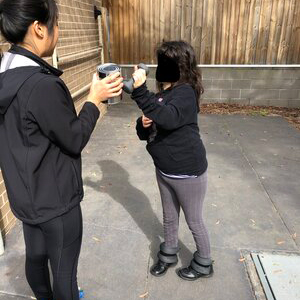
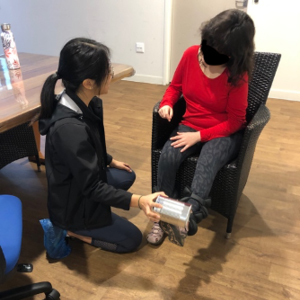
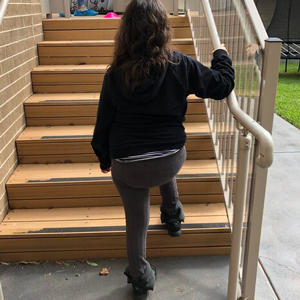
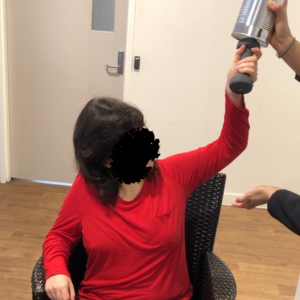
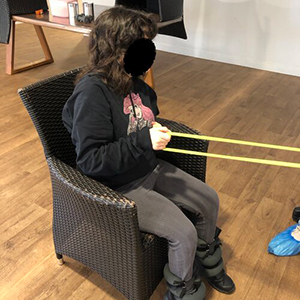
Here is Hannah completing her forward punches, knee extensions , stair climbing, shoulder press and seating rows. As you can see, Hannah taps or kicks a tin with marbles which provides her with pleasant sensory feedback, important to her because of her Autism diagnosis. Hannah loves listening to music during her exercise sessions; it encourages and motivates her, keeping her exercise session fun & engaging!
Do you or your client have Prader-Willi Syndrome? Would you like some help setting up an exercise or dietetic program to achieve your goals?
Written by Bianca Chan, Active Ability’s exercise physiologist
Bianca provides exercise physiology services in the Hills District of Sydney. She sees clients in Castle Hill, Cherrybrook, Kellyville, Dural & Rouse Hill as well as Beecroft, Carlingford, Parramatta and Ryde.
References:
Cassidy, S. B., Schwartz, S., Miller, J. L., & Driscoll, D. J. (2012). Prader-willi syndrome. Genetics in Medicine, 14(1), 10-26.
Prader-Willi Syndrome Australia (2016). About Prader-Willi Syndrome https://www.pws.org.au/prader-willi-syndrome/
National Institutes of Health: U.S National Library of Medicine – Genetics Home Reference (2014) Prader-Willi Syndrome, https://ghr.nlm.nih.gov/condition/prader-willi-syndrome
Butler, J. V., Whittington, J. E., Holland, A. J., Boer, H., Clarke, D., & Webb, T. (2002). Prevalence of, and risk factors for, physical ill-health in people with Prader-Willi syndrome: a population-based study. Developmental medicine and child neurology, 44(4), 248-255.
*an alias name has been used to maintain the client’s confidentiality